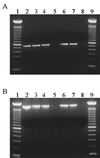Evaluation of Cryptosporidium parvum genotyping techniques
- PMID: 10508071
- PMCID: PMC91589
- DOI: 10.1128/AEM.65.10.4431-4435.1999
Evaluation of Cryptosporidium parvum genotyping techniques
Abstract
We evaluated the specificity and sensitivity of 11 previously described species differentiation and genotyping PCR protocols for detection of Cryptosporidium parasites. Genomic DNA from three species of Cryptosporidium parasites (genotype 1 and genotype 2 of C. parvum, C. muris, and C. serpentis), two Eimeria species (E. neischulzi and E. papillata), and Giardia duodenalis were used to evaluate the specificity of primers. Furthermore, the sensitivity of the genotyping primers was tested by using genomic DNA isolated from known numbers of oocysts obtained from a genotype 2 C. parvum isolate. PCR amplification was repeated at least three times with all of the primer pairs. Of the 11 protocols studied, 10 amplified C. parvum genotypes 1 and 2, and the expected fragment sizes were obtained. Our results indicate that two species-differentiating protocols are not Cryptosporidium specific, as the primers used in these protocols also amplified the DNA of Eimeria species. The sensitivity studies revealed that two nested PCR-restriction fragment length polymorphism (RFLP) protocols based on the small-subunit rRNA and dihydrofolate reductase genes are more sensitive than single-round PCR or PCR-RFLP protocols.
Figures

Similar articles
-
Species-specific, nested PCR-restriction fragment length polymorphism detection of single Cryptosporidium parvum oocysts.Appl Environ Microbiol. 2001 Jun;67(6):2665-8. doi: 10.1128/AEM.67.6.2665-2668.2001. Appl Environ Microbiol. 2001. PMID: 11375178 Free PMC article.
-
An evaluation of primers amplifying DNA targets for the detection of Cryptosporidium spp. using C. parvum HNJ-1 Japanese isolate in water samples.Parasitol Res. 2007 Sep;101(4):951-62. doi: 10.1007/s00436-007-0567-y. Epub 2007 May 19. Parasitol Res. 2007. PMID: 17514380
-
A multiplex allele specific polymerase chain reaction (MAS-PCR) on the dihydrofolate reductase gene for the detection of Cryptosporidium parvum genotypes 1 and 2.Parasitology. 2002 Jul;125(Pt 1):35-44. doi: 10.1017/s0031182002001786. Parasitology. 2002. PMID: 12166518
-
Detection and species identification of Cryptosporidium oocysts using a system based on PCR and endonuclease restriction.Parasitology. 1994 Jul;109 ( Pt 1):19-22. doi: 10.1017/s0031182000077714. Parasitology. 1994. PMID: 8058364
-
[Comparative study of PCR-based Cryptosporidium discriminating techniques with a review of the literature].Kansenshogaku Zasshi. 2002 Oct;76(10):869-81. doi: 10.11150/kansenshogakuzasshi1970.76.869. Kansenshogaku Zasshi. 2002. PMID: 12448847 Review. Japanese.
Cited by
-
Detection of Cryptosporidium spp. from human faeces by PCR-RFLP, cloning and sequencing.Parasitol Res. 2009 Feb;104(3):583-7. doi: 10.1007/s00436-008-1233-8. Epub 2008 Nov 1. Parasitol Res. 2009. PMID: 18979120
-
Identification of Cryptosporidium spp. oocysts in United Kingdom noncarbonated natural mineral waters and drinking waters by using a modified nested PCR-restriction fragment length polymorphism assay.Appl Environ Microbiol. 2003 Jul;69(7):4183-9. doi: 10.1128/AEM.69.7.4183-4189.2003. Appl Environ Microbiol. 2003. PMID: 12839797 Free PMC article.
-
Species-specific, nested PCR-restriction fragment length polymorphism detection of single Cryptosporidium parvum oocysts.Appl Environ Microbiol. 2001 Jun;67(6):2665-8. doi: 10.1128/AEM.67.6.2665-2668.2001. Appl Environ Microbiol. 2001. PMID: 11375178 Free PMC article.
-
Comparison of method 1623 and cell culture-PCR for detection of Cryptosporidium spp. in source waters.Appl Environ Microbiol. 2003 Feb;69(2):971-9. doi: 10.1128/AEM.69.2.971-979.2003. Appl Environ Microbiol. 2003. PMID: 12571019 Free PMC article.
-
Comparison of diagnostic techniques for the detection of Cryptosporidium oocysts in animal samples.Exp Parasitol. 2015 Apr-May;151-152:14-20. doi: 10.1016/j.exppara.2015.01.018. Epub 2015 Feb 3. Exp Parasitol. 2015. PMID: 25662435 Free PMC article.
References
-
- Arrowood M J, Sterling C R. Isolation of Cryptosporidium oocysts and sporozoites using discontinuous sucrose and isopycnic Percoll gradients. J Parasitol. 1987;73:314–319. - PubMed
-
- Awad-El-Kariem F M, Warhurst D C, McDonald V. Detection of Cryptosporidium oocysts using a system based on PCR and endonuclease restriction. Parasitology. 1994;109:19–22. - PubMed
-
- Bonnin A, Fourmaux M N, Dubremetz J F, Nelson R G, Gobet P, Harly G, Buisson M, Puygauthier-Toubas D, Gabriel-Pospisil F, Naciri M, Camerlynch P. Genotyping human and bovine isolates of Cryptosporidium parvum by polymerase chain reaction-restriction fragment length polymorphism analysis of a repetitive DNA sequence. FEMS Microbiol Lett. 1996;137:207–211. - PubMed
-
- Cai J, Collins M D, McDonald V, Thompson D E. PCR cloning and nucleotide sequence determination of the 18S rRNA genes and internal transcribed spacer 1 of the protozoan parasites Cryptosporidium parvum and Cryptosporidium muris. Biochim Biophys Acta. 1992;1131:317–320. - PubMed
Publication types
MeSH terms
Substances
Associated data
- Actions
- Actions
- Actions
- Actions
Grants and funding
LinkOut - more resources
Full Text Sources

